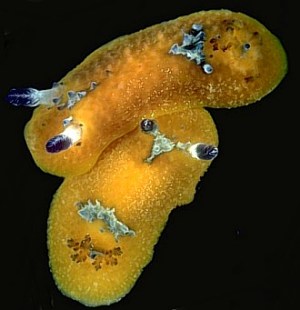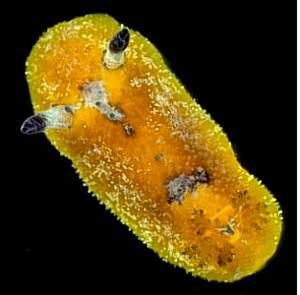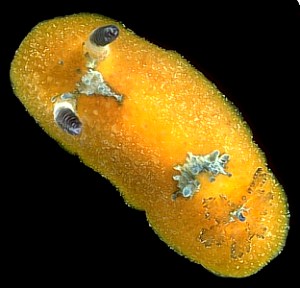
Siraius immonda
(Risbec, 1928)
Order: NUDIBRANCHIA
Suborder: DORIDINA
Superfamily: EUDORIDOIDEA
Family: Dorididae
DISTRIBUTION
Previously known only from Western Pacific, but reported here [message #21906 ] from the Red Sea.
PHOTO
Upper & Lower right: Solitary Ids., Coffs Hbr region, NSW, 3 Nov 1990. C164157. Lower left: Pointe de Pandop, Koumac, New Caledonia, 20°35.2'S, 164°16.6'E, 2m, Hard substrate 18 October 1993, 11mm long alive. Photos: Bill Rudman.
Risbec (1928) described a yellow orange dorid with purplish elongate rhinophores and a tuberculated inverted Y pattern on its dorsum. It had an orange egg mass. His description and an examination of the type specimen in the Paris Museum show that this species is the same as the species exhaustively described (Brodie & Willan, 1993) from Queensland and Norfolk Island as Siraius nucleola (Pease). I have posted a copy of Risbec's painting below. It is characterised by a firm ovate tuberculate mantle, usually a dull yellow brown but sometimes darker, with an hourglass pattern between the gills and the rhinophores. Theis pattern may be broken into an anterior and posterior patch. The underside is orange-yellow.
I cannot agree with Brodie & Willan's synonymy of Platydoris immonda Risbec with Doris nucleola Pease, Doriorbis nucleola Kay & Young, or Doris carinata Alder & Hancock. In Pease's description of D.nucleola no mention is made of any dorsal markings between the gills and rhinophores, and none are illustrated in Garret's illustration (Bergh, 1881). To confuse things more, it is unlikely that the animal Kay & Young, (1969) identified as Doriorbis nucleola (Pease), with a prominent T or Y shaped pattern between the gills and rhinophores, is either Pease's species or Risbec's.
Brodie & Willan also consider Doris carinata Alder & Hancock (1864) to be a synonym. The shape of the median dorsal patch is similar but the high body profile are quite different from S. immonda. Also, the description of the gills as `numerous .. forming a complete circle' differs markedly from the 5 gills in S. immonda. While many of Alder & Hancock's species are easily identified, there are others which will remain problematic. Subsequent to Brodie & Willan, Baba (1993) identified a Japanese species with Siraius nucleola sensu Brodie & Willan.
It does not seem possible to clarify the identity of all the old names. There are many nodulose dorids with an elongate colour patch between the gills and the rhinophores. The species described by Brodie & Willan from eastern Australia and Norfolk Island, and Baba from Japan, is clearly identical to Risbec's Platydoris immonda. Until further material of Hawaiian and Indian specimens are available, further attempts at matching names from those regions with species from the southwestern Pacific will be unrewarding. I have followed Brodie & Willan in placing this species in the genus Siraius.
References:
•Baba, K (1993) A new record of Siraius nucleola (Pease, 1860) (Nudibranchia: Dorididae) from Japan. Venus, The Japanese Journal of Malacology 52(4): 291-297.
•Bergh, L.S.R. (1881) Nachtrage. Malacologische Untersuchungen. In: C.G. Semper, Reisen im Archipel der Philippinen, Wissenschaftliche Resultate. Band 2, Supplement 2.: 79-128, Pls.G, H, J-L.
• Brodie, G.D. & Willan, R.C (1993) Redescription and taxonomic reappraisal of the tropical Indo-Pacific nudibranch Siraius nucleola (Pease, 1860) (Anthobranchia: Doridoidea: Dorididae). The Veliger 36(2): 124-133.
•Kay, E.A. & Young, D.K. (1969) The Doridacea (Opisthobranchia: Mollusca) of the Hawaiian Islands. Pacific Science 23(2): 172-231.
•Pease, W.H. (1860) Descriptions of new species of Mollusca from the Sandwich Islands.
Proceedings of the Zoological Society of London 28: 18-36.
•Risbec, J. (1928) Contribution a l'etude des nudibranches Neo-Caledoniens. Faune des Colonies Francaises 2(1): 1-328, Pls.1-12.


Rudman, W.B., 2000 (April 14) Siraius immonda (Risbec, 1928). [In] Sea Slug Forum. Australian Museum, Sydney. Available from http://www.seaslugforum.net/factsheet/siraimmo
Related messages
-
Siraius immonda? from the Red Sea
From: Erwin Koehler, September 23, 2008 -
Re: Siraius immonda from sthn Queensland [2]
From: Bruce Wilkie, May 26, 2007 -
Re: Siraius immonda from sthn Queensland
From: Gary Cobb, May 25, 2007 -
Siraius immonda from sthn Queensland
From: Gary Cobb, May 21, 2007 -
Siraius immonda from Japan
From: Yasuhiro Shirai, April 18, 2000
